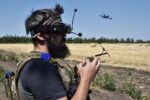At AUSA 2025 in Washington D.C., Venator Systems unveiled its new “Flycat” loitering munition—an attritable Group 3 UAV designed to meet the U.S. Army’s evolving demand for scalable strike-capable drones that blend ISR and kinetic effects under contested conditions. The system reflects a growing doctrinal shift toward low-cost, networked unmanned assets capable of saturating enemy defenses while preserving high-end platforms.
Flycat Overview: Specs and Design Philosophy
The Flycat is a fixed-wing loitering munition falling within Group 3 UAV classification (typically <600 kg MTOW), with a reported wingspan of approximately 3 meters and an endurance of up to 6 hours depending on payload configuration. Designed for modularity and rapid field deployment, the airframe is optimized for both ISR and kinetic strike roles using swappable mission modules.
Key specifications include:
- Weight: Approx. 55–70 kg (depending on payload)
- Endurance: Up to 6 hours
- Range: >150 km operational radius (line-of-sight)
- Payloads: EO/IR gimbals, RF sensors, or kinetic warheads (~5–10 kg class)
- Propulsion: Electric pusher motor with low acoustic signature
The system is designed for runway-independent launch via catapult or vehicle-mounted rail and can be recovered via parachute or expendable terminal dive depending on mission profile.
Aimed Squarely at the U.S. Army’s Attritable Drone Strategy
The Flycat aligns with the U.S. Army’s stated intent—articulated in recent RFI/RFIs and strategy documents—to field large volumes of affordable unmanned systems capable of operating in GPS-contested environments with minimal operator burden. This includes participation in programs like the Future Tactical Unmanned Aircraft System (FTUAS) and broader Replicator initiative led by OSD.
“Attritable” drones occupy a middle ground between expendable munitions like Switchblade and high-end platforms like MQ-1C Gray Eagle ER. The Flycat appears positioned to fill this niche by offering multi-mission flexibility at unit-level cost points (~$100K–$250K per unit estimated based on comparable systems).
Cognitive Autonomy and Networked Operations
Venator claims that Flycat incorporates edge-AI processing for onboard target recognition and autonomous navigation in GNSS-denied environments—a key requirement given adversary jamming capabilities observed in Ukraine and projected peer conflicts.
This includes:
- Visual-based navigation: Terrain-relative mapping using EO sensors
- Cognitive targeting algorithms: For vehicle class/type ID without uplink latency
- MUM-T compatibility: Interoperability with manned platforms via Link-16 or ATAK plugins
The drone can operate as part of a swarm or semi-autonomously under human-on-the-loop control architecture, allowing distributed teams to deploy multiple units simultaneously without saturating C2 bandwidth.
Kinetic Effects and ISR Payload Flexibility
The Flycat supports multiple payload configurations including modular warheads (HE-FRAG or shaped charge) as well as EO/IR gimbals for persistent surveillance or battle damage assessment (BDA). The warhead module features selectable fuzing options—impact or proximity—to optimize effects against armor or soft targets.
This dual-role capability enables commanders to use the same platform across kill chain functions—from target acquisition through terminal strike—simplifying logistics while increasing operational tempo.
Competitive Landscape: How Flycat Stacks Up
The market for attritable Group 3 loitering munitions is increasingly crowded post-Ukraine war lessons learned. Systems such as Anduril’s ALTIUS-700M, AeroVironment’s Switchblade X variant (in development), and Shield AI’s V-BAT are all vying for similar mission sets.
Differentiators claimed by Venator include:
- Simplified logistics chain: Field-replaceable modules & hot-swappable payloads
- Civilian-derived COTS components: Lower cost base & faster production ramp-up
- Semi-autonomous swarm logic: Enables saturation tactics without full autonomy risks
No formal procurement contract has been announced yet; however, sources indicate that Venator has submitted proposals under at least two classified OTAs related to tactical drone experimentation battalions stood up within FORSCOM units.
AUSA Reveal Highlights Growing Demand for Scalable Kill Web Assets
The unveiling at AUSA underscores how rapidly industry is responding to doctrinal shifts toward distributed lethality and kill web architectures. With increasing emphasis on contested-domain survivability—especially against peer IADS—the need for low-cost ISR-strike drones that can be deployed en masse is now central to both Army Futures Command planning and Joint All-Domain Operations (JADO) concepts.
If successfully integrated into brigade-level formations or Special Operations Forces kits, platforms like Flycat could enable persistent overwatch and precision strike at unprecedented scale without overrelying on vulnerable satellite links or expensive HALE assets.










